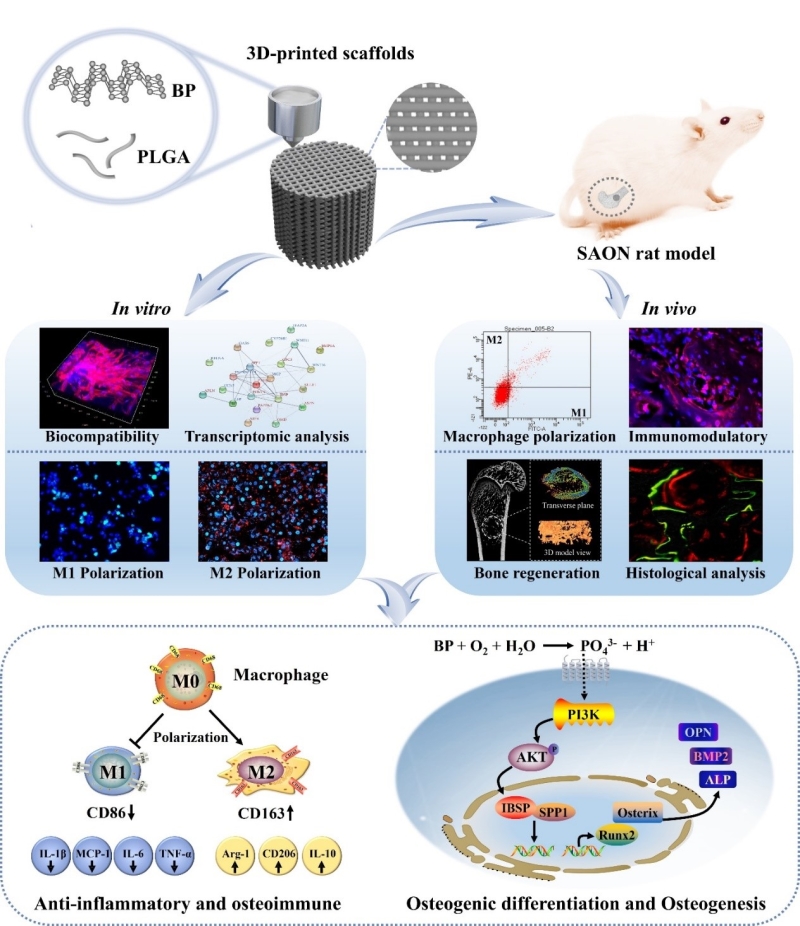Novel 3D-Printed Black Phosphorus Scaffolds for Bone Immunomodulation and Enhanced Bone Regeneration
Date:12-09-2023 | 【Print】 【close】
A research group led by Prof. LAI Yuxiao from the Shenzhen Institute of Advanced Technology, Chinese Academy of Sciences developed a biodegradable polymer lactate-glycolic acid (PLGA) combined with black phosphorus (BP) multi-functional bionic porous scaffolds using a unique low-temperature 3D printing technology. They demonstrated the macrophage polarization to regulate osteoimmune microenvironment and bone regeneration.
The study was published in Advanced Science on Aug. 24.
The treatment of bone defects remains a major challenge. 3D printed scaffolds have attracted much attention in orthopedics. Implanted bone scaffolds often do not integrate successfully with host tissue because they do not elicit a favorable immune response. The properties of the bone scaffold not only provide mechanical and biocompatibility to support cell adhesion, migration, proliferation and differentiation, but also play a critical role in determining the extent of the immune response during bone regeneration.
BP is a novel 2D material that researchers have paid more attention to in recent years due to its unique and excellent properties. Compared to other two-dimensional materials, BP is biocompatible and biodegradable in the physiological environment. Phosphate anions are nontoxic degradation products of BP, which are important for bone tissue mineralization. While it has been reported that biomaterials based on BP can promote bone regeneration, little is known about whether BP regulates the immunological microenvironment of bone.
Immunomodulatory properties of orthopedic biomaterials have significance in regulating osteoimmune microenvironment for osteogenesis. The researchers synthesized a innovative porous PLGA/BP scaffolds by 3D printing technology and investigated the effect of BP on osteoimmunomodulation and osteogenesis in site. First, the PLGA/BP scaffold has suitable biocompatibility, biodegradability and mechanical properties, and phosphate anions are degradation products of BP, which are important for bone tissue mineralization. Second, the researchers found that BP scaffolds can recruit macrophages and stimulate macrophages from M1 to M2 polarization to inhibit inflammation and promote bone regeneration. Through transcriptome analysis of BMSC cells, the researchers also demonstrated that the BP scaffolds can promote IBSP and SPP1 expression, osteogenic differentiation, and osteogenic behavior via the PI3K-AKT pathways. Finally, the investigators presented a clinical challenge targeting osteoimmunomodulation and osteogenesis for the treatment of rat steroid-associated osteonecrosis (SAON), a common orthopedic disease caused by long-term and massive use of corticosteroids.
The 3D-printed PLGA/BP scaffolds exhibited excellent osteoimmunomodulatory efficacy, osteogenic capacity and great biocompatibility, ensuring great potential for further clinical implementation.

Schematic illustration of nanosized black phosphorus scaffolds fabricated by 3D printing and the proposed mechanism of osteoimmune environment induced by black phosphorus degradation to accelerate bone regeneration (Image by SIAT).
Media Contact:
ZHANG Xiaomin
Email:xm.zhang@siat.ac.cn